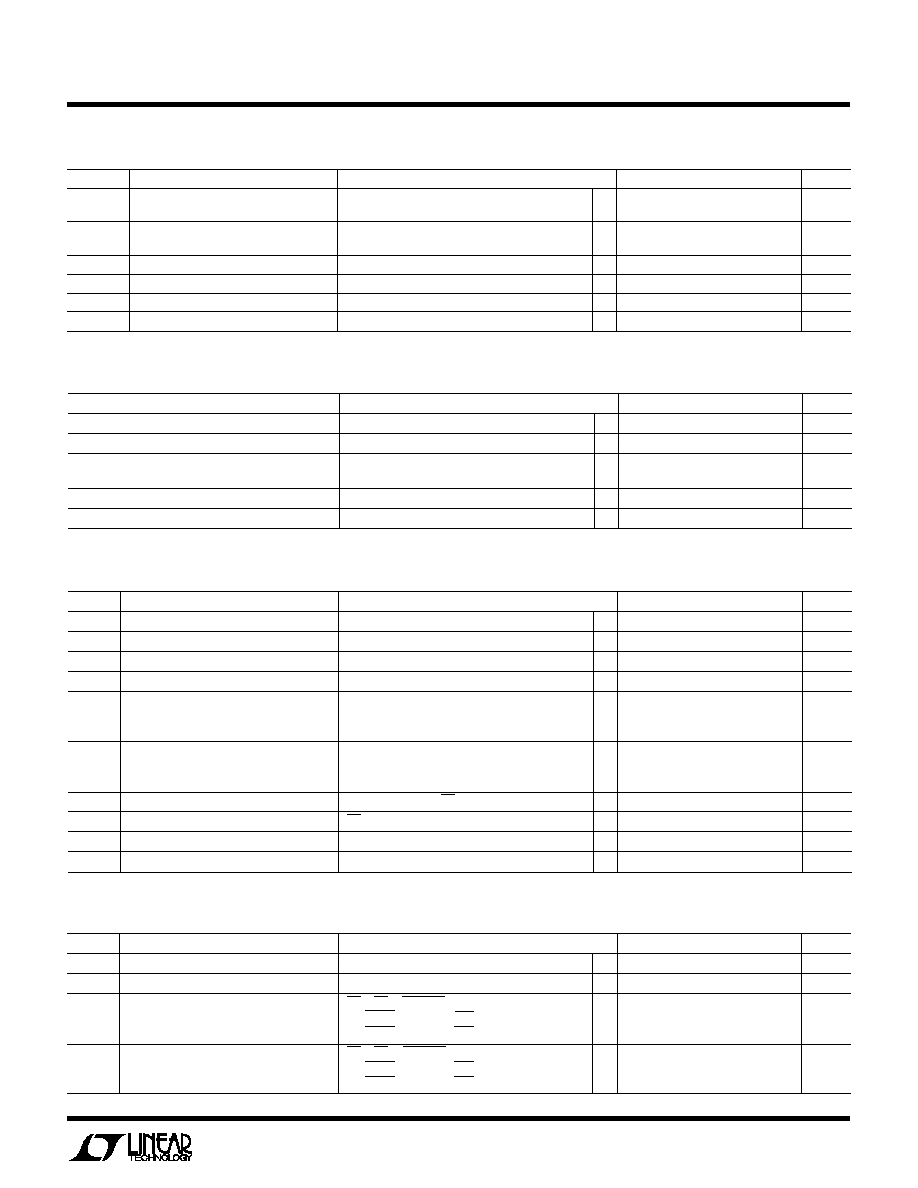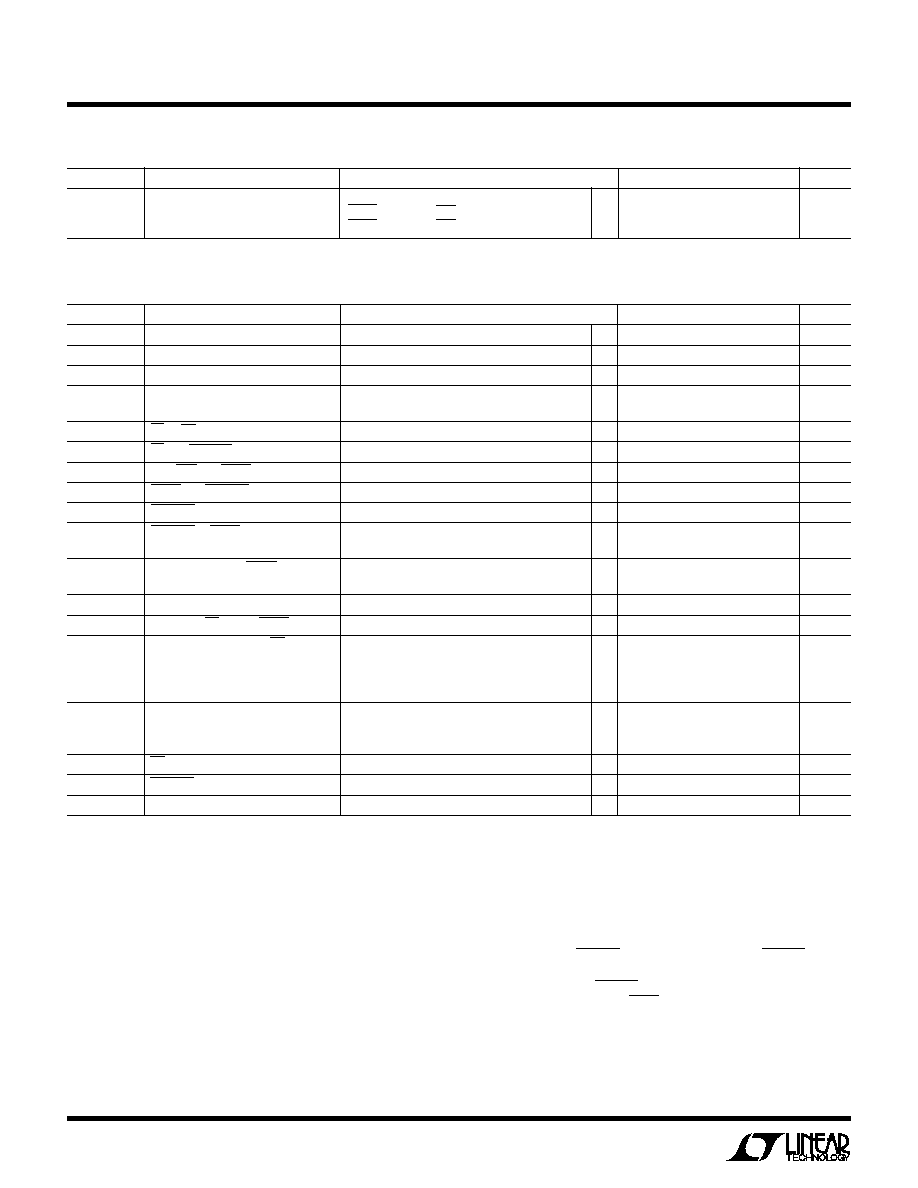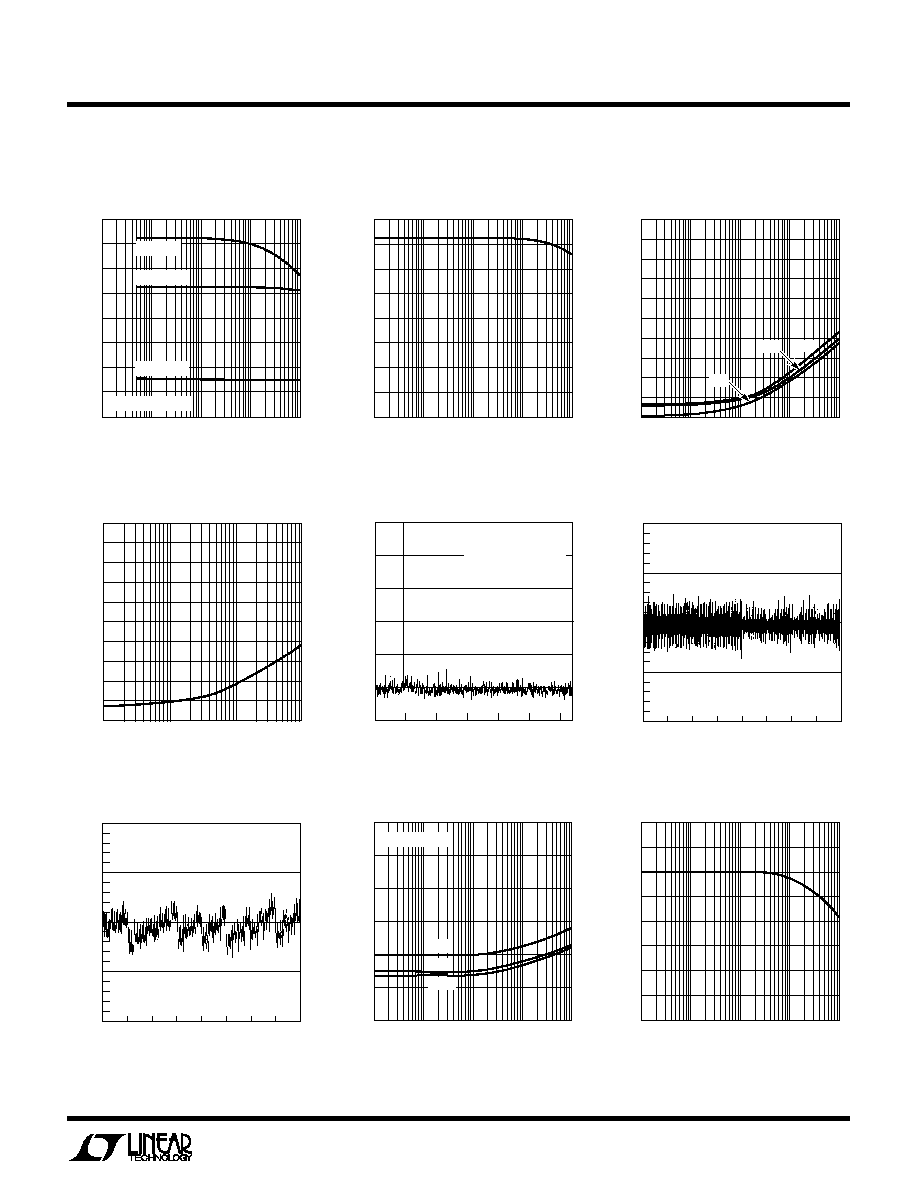 | –≠–ª–µ–∫—Ç—Ä–æ–Ω–Ω—ã–π –∫–æ–º–ø–æ–Ω–µ–Ω—Ç: LTC1410CG | –°–∫–∞—á–∞—Ç—å:  PDF PDF  ZIP ZIP |

1
LTC1410
12-Bit, 1.25Msps Sampling
A/D Converter with Shutdown
S
FEATURE
D
U
ESCRIPTIO
The LTC
Æ
1410 is a 0.65
µ
s, 1.25Msps, 12-bit sampling
A/D converter that draws only 160mW from
±
5V supplies.
This easy-to-use device includes a high dynamic range
sample-and-hold, a precision reference and requires no
external components. Two digitally selectable power shut-
down modes provide flexibility for low power systems.
The LTC1410's full-scale input range is
±
2.5V. Maximum
DC specifications include
±
1LSB INL and
±
1LSB DNL over
temperature. Outstanding AC performance includes 71dB
S/(N + D) and 82dB THD at the Nyquist input frequency of
625kHz.
The unique differential input sample-and-hold can acquire
single-ended or differential input signals up to its 20MHz
bandwidth. The 60dB common mode rejection allows
users to eliminate ground loops and common mode noise
by measuring signals differentially from the source.
The ADC has a
µ
P compatible, 12-bit parallel output port.
There is no pipeline delay in the conversion results. A
separate convert start input and a data ready signal (BUSY)
ease connections to FIFOs, DSPs and microprocessors.
s
1.25Msps Sample Rate
s
Power Dissipation: 160mW
s
71dB S/(N + D) and 82dB THD at Nyquist
s
No Pipeline Delay
s
Nap (7mW) and Sleep (10
µ
W) Shutdown Modes
s
Operates with Internal 15ppm/
∞
C Reference
or External Reference
s
True Differential Inputs Reject Common Mode Noise
s
20MHz Full Power Bandwidth Sampling
s
±
2.5V Bipolar Input Range
s
28-Pin SO Wide Package
U
S
A
O
PPLICATI
s
Telecommunications
s
Digital Signal Processing
s
Multiplexed Data Acquisition Systems
s
High Speed Data Acquisition
s
Spectrum Analysis
s
Imaging Systems
, LTC and LT are registered trademarks of Linear Technology Corporation.
U
A
O
PPLICATI
TYPICAL
Complete 1.25MHz, 12-Bit Sampling A/D Converter
Effective Bits and Signal-to-(Noise + Distortion)
vs Input Frequency
INPUT FREQUENCY (Hz)
2
EFFECTIVE BITS
S/(N + D) (dB)
4
6
8
10
10k
100k
1M
10M
LTC1410 ∑ TA02
0
1k
12
74
68
62
56
50
f
SAMPLE
= 1.25MHz
NYQUIST
1
2
3
4
5
6
7
8
9
10
11
12
13
14
28
27
26
25
24
23
22
21
20
19
18
17
16
15
LTC1410
0.1
µ
F
+
10
µ
F
DIFFERENTIAL
ANALOG INPUT
(≠2.5V TO 2.5V)
2.50V
V
REF
OUTPUT
10
µ
F
10
µ
F
0.1
µ
F
0.1
µ
F
≠5V
5V
12-BIT
PARALLEL
BUS
µ
P CONTROL
LINES
1410 TA01
+
+A
IN
≠A
IN
V
REF
REFCOMP
AGND
D11(MSB)
D10
D9
D8
D7
D6
D5
D4
DGND
AV
DD
DV
DD
V
SS
BUSY
CS
CONVST
RD
SHDN
NAP/SLP
OGND
D0
D1
D2
D3

2
LTC1410
AV
DD
= DV
DD
= V
DD
(Notes 1, 2)
Supply Voltage (V
DD
) ................................................ 6V
Negative Supply Voltage (V
SS
) ............................... ≠ 6V
Total Supply Voltage (V
DD
to V
SS
) .......................... 12V
Analog Input Voltage
(Note 3) .................................. V
SS
≠ 0.3V to V
DD
+ 0.3V
Digital Input Voltage (Note 4) ............ V
SS
≠ 0.3V to 10V
Digital Output Voltage ...................
≠ 0.3V to V
DD
+ 0.3V
Power Dissipation ............................................. 500mW
Operating Temperature Range
LTC1410C .............................................. 0
∞
C to 70
∞
C
LTC1410I ........................................... ≠ 40
∞
C to 85
∞
C
Storage Temperature Range ................ ≠ 65
∞
C to 150
∞
C
Lead Temperature (Soldering, 10 sec)................. 300
∞
C
A
U
G
W
A
W
U
W
A
R
BSOLUTE
XI
TI
S
W
U
U
PACKAGE/ORDER I FOR ATIO
ORDER
PART NUMBER
Consult factory for Military grade parts.
PUT
U
I
A
A
U
LOG
PARAMETER
CONDITIONS
MIN
TYP
MAX
UNITS
Resolution (No Missing Codes)
q
12
Bits
Integral Linearity Error
(Note 7)
q
±
0.3
±
1
LSB
Differential Linearity Error
q
±
0.3
±
1
LSB
Offset Error
(Note 8)
±
2
±
6
LSB
q
±
8
LSB
Full-Scale Error
±
15
LSB
Full-Scale Tempco
I
OUT(REF)
= 0
q
±
15
ppm/
∞
C
T
JMAX
= 110
∞
C,
JA
= 90
∞
C/W (SW)
T
JMAX
= 110
∞
C,
JA
= 95
∞
C/W (G)
1
2
3
4
5
6
7
8
9
10
11
12
13
14
28
27
26
25
24
23
22
21
20
19
18
17
16
15
+A
IN
≠A
IN
V
REF
REFCOMP
AGND
D11(MSB)
D10
D9
D8
D7
D6
D5
D4
DGND
AV
DD
DV
DD
V
SS
BUSY
CS
CONVST
RD
SHDN
NAP/SLP
OGND
D0
D1
D2
D3
G PACKAGE
28-LEAD PLASTIC SSOP
SW PACKAGE
28-LEAD PLASTIC SO WIDE
TOP VIEW
LTC1410CG
LTC1410CSW
LTC1410IG
LTC1410ISW
C
C
HARA TERISTICS
CO
U
VERTER
The
q
denotes specifications which apply over the full operating
temperature range, otherwise specifications are at T
A
= 25
∞
C. With Internal Reference (Notes 5, 6)
The
q
denotes specifications which apply over the full operating temperature range, otherwise
specifications are at T
A
= 25
∞
C. (Note 5)
SYMBOL
PARAMETER
CONDITIONS
MIN
TYP
MAX
UNITS
V
IN
Analog Input Range (Note 9)
4.75V
V
DD
5.25V, ≠ 5.25V
V
SS
≠ 4.75V
q
±
2.5
V
I
IN
Analog Input Leakage Current
CS = High
q
±
1
µ
A
C
IN
Analog Input Capacitance
Between Conversions
17
pF
During Conversions
5
pF
t
ACQ
Sample-and-Hold Acquisition Time
q
50
100
ns
t
AP
Sample-and-Hold Aperture Delay Time
≠1.5
ns
t
jitter
Sample-and-Hold Aperture Delay Time Jitter
5
ps
RMS
CMRR
Analog Input Common Mode Rejection Ratio
≠ 2.5V < (≠ A
IN
= A
IN
) < 2.5V
60
dB

3
LTC1410
ACCURACY
IC
DY
U
W
A
The
q
denotes specifications which apply over the full operating temperature range,
otherwise specifications are at T
A
= 25
∞
C. (Note 5)
SYMBOL
PARAMETER
CONDITIONS
MIN
TYP
MAX
UNITS
S/(N + D)
Signal-to-(Noise + Distortion) Ratio
100kHz Input Signal (Note 12)
q
70
72.5
dB
600kHz Input Signal (Note 12)
q
68
71.0
dB
THD
Total Harmonic Distortion
100kHz Input Signal, First 5 Harmonics
≠ 85
dB
600kHz Input Signal, First 5 Harmonics
q
≠ 82
≠ 74
dB
Peak Harmonic or Spurious Noise
600kHz Input Signal
q
≠ 84
≠ 74
dB
IMD
Intermodulation Distortion
f
IN1
= 29.37kHz, f
IN2
= 32.446kHz
≠ 84
dB
Full Power Bandwidth
20
MHz
Full Linear Bandwidth
(S/(N + D)
68dB)
2.5
MHz
DIGITAL I PUTS A D DIGITAL OUTPUTS
U
U
The
q
denotes specifications which apply over the full
operating temperature range, otherwise specifications are at T
A
= 25
∞
C. (Note 5)
SYMBOL
PARAMETER
CONDITIONS
MIN
TYP
MAX
UNITS
V
IH
High Level Input Voltage
V
DD
= 5.25V
q
2.4
V
V
IL
Low Level Input Voltage
V
DD
= 4.75V
q
0.8
V
I
IN
Digital Input Current
V
IN
= 0V to V
DD
q
±
10
µ
A
C
IN
Digital Input Capacitance
5
pF
V
OH
High Level Output Voltage
V
DD
= 4.75V
I
O
= ≠ 10
µ
A
4.5
V
I
O
= ≠ 200
µ
A
q
4.0
V
V
OL
Low Level Output Voltage
V
DD
= 4.75V
I
O
= 160
µ
A
0.05
V
I
O
= 1.6mA
q
0.10
0.4
V
I
OZ
High-Z Output Leakage D11 to D0
V
OUT
= 0V to V
DD
, CS High
q
±
10
µ
A
C
OZ
High-Z Output Capacitance D11 to D0
CS High (Note 9 )
q
15
pF
I
SOURCE
Output Source Current
V
OUT
= 0V
≠ 10
mA
I
SINK
Output Sink Current
V
OUT
= V
DD
10
mA
I TER AL REFERE CE CHARACTERISTICS
U
U
U
The
q
denotes specifications which apply over the full
operating temperature range, otherwise specifications are at T
A
= 25
∞
C. (Note 5)
PARAMETER
CONDITIONS
MIN
TYP
MAX
UNITS
V
REF
Output Voltage
I
OUT
= 0
2.480
2.500
2.520
V
V
REF
Output Tempco
I
OUT
= 0
±
15
ppm/
∞
C
V
REF
Line Regulation
4.75V
V
DD
5.25V
0.01
LSB/V
≠ 5.25V
V
SS
≠ 4.75V
0.01
LSB/V
V
REF
Output Resistance
I
OUT
0.1mA
2
k
COMP Output Voltage
I
OUT
= 0
4.06
V
SYMBOL
PARAMETER
CONDITIONS
MIN
TYP
MAX
UNITS
V
DD
Positive Supply Voltage
(Notes 10, 11)
4.75
5.25
V
V
SS
Negative Supply Voltage
(Note 10)
≠ 4.75
≠ 5.25
V
I
DD
Positive Supply Current
CS = RD = CONVST = 5V
q
12
16
mA
Nap Mode
SHDN = 0V, NAP/SLP = 5V
1.5
2.3
mA
Sleep Mode
SHDN = 0V, NAP/SLP = 0V
1
100
µ
A
I
SS
Negative Supply Current
CS = RD = CONVST = 5V
q
20
30
mA
Nap Mode
SHDN = 0V, NAP/SLP = 5V
10
200
µ
A
Sleep Mode
SHDN = 0V, NAP/SLP = 0V
1
100
µ
A
POWER REQUIRE E TS
W U
The
q
denotes specifications which apply over the full operating temperature range,
otherwise specifications are at T
A
= 25
∞
C. (Note 5)

4
LTC1410
POWER REQUIRE E TS
W U
The
q
denotes specifications which apply over the full operating temperature range,
otherwise specifications are at T
A
= 25
∞
C. (Note 5)
SYMBOL
PARAMETER
CONDITIONS
MIN
TYP
MAX
UNITS
P
D
Power Dissipation
160
230
mW
Nap Mode
SHDN = 0V, NAP/SLP = 5V
7.5
12
mW
Sleep Mode
SHDN = 0V, NAP/SLP = 0V
0.01
1
mW
SYMBOL
PARAMETER
CONDITIONS
MIN
TYP
MAX
UNITS
f
SAMPLE(MAX)
Maximum Sampling Frequency
q
1.25
MHz
t
CONV
Conversion Time
q
650
750
ns
t
ACQ
Acquisition Time
q
50
100
ns
t
ACQ+CONV
Throughput Time
q
800
ns
(Acquisition + Conversion)
t
1
CS to RD Setup Time
(Notes 9, 10)
q
0
ns
t
2
CS
to CONVST
Setup Time
(Notes 9, 10)
q
10
ns
t
3
NAP/SLP
to SHDN
Setup Time
(Notes 9, 10)
q
10
ns
t
4
SHDN
to CONVST
Wake-Up Time
(Note 10)
200
ns
t
5
CONVST
Low Time
(Notes 10, 11)
q
40
ns
t
6
CONVST to BUSY Delay
C
L
= 25pF
10
ns
q
50
ns
t
7
Data Ready Before BUSY
20
35
ns
q
15
ns
t
8
Delay Between Conversions
(Note 10)
q
40
ns
t
9
Wait Time RD
After BUSY
(Note 10)
q
≠ 5
ns
t
10
Data Access Time After RD
C
L
= 25pF
15
25
ns
q
35
ns
C
L
= 100pF
20
35
ns
q
50
ns
t
11
Bus Relinquish Time
8
20
ns
Commercial
q
25
ns
Industrial
q
30
ns
t
12
RD Low Time
q
t
10
ns
t
13
CONVST High Time
q
40
ns
t
14
Aperture Delay of Sample-and-Hold
≠ 1.5
ns
TI I G CHARACTERISTICS
W U
The
q
denotes specifications which apply over the full operating temperature
range, otherwise specifications are at T
A
= 25
∞
C. (Note 5)
Note 7: Integral nonlinearity is defined as the deviation of a code from a
straight line passing through the actual endpoints of the transfer curve.
The deviation is measured from the center of the quantization band.
Note 8: Bipolar offset is the offset voltage measured from ≠ 0.5LSB when
the output code flickers between 0000 0000 0000 and 1111 1111 1111.
Note 9: Guaranteed by design, not subject to test.
Note 10: Recommended operating conditions.
Note 11: The falling CONVST edge starts a conversion. If CONVST returns
high at a critical point during the conversion it can create small errors. For
best results ensure that CONVST returns high either within 425ns after the
start of the conversion or after BUSY rises.
Note 12: Signal-to-noise ratio (SNR) is measured at 100kHz and distortion
is measured at 600kHz. These results are used to calculate signal-to-noise
plus distortion (SINAD).
Note 1: Absolute Maximum Ratings are those values beyond which the life
of a device may be impaired.
Note 2: All voltage values are with respect to ground with DGND, OGND
and AGND wired together unless otherwise noted.
Note 3: When these pin voltages are taken below V
SS
or above V
DD
, they
will be clamped by internal diodes. This product can handle input currents
greater than 100mA below V
SS
or above V
DD
without latchup.
Note 4: When these pin voltages are taken below V
SS
, they will be clamped
by internal diodes. This product can handle input currents greater than
100mA below V
SS
without latchup. These pins are not clamped to V
DD
.
Note 5: V
DD
= 5V, V
SS
= ≠ 5V, f
SAMPLE
= 1.25MHz, t
r
= t
f
= 5ns unless
otherwise specified.
Note 6: Linearity, offset and full-scale specifications apply for a single-
ended +A
IN
input with ≠ A
IN
grounded.

5
LTC1410
TYPICAL PERFOR
M
A
N
CE CHARACTERISTICS
U
W
S/(N + D) vs Input Frequency
and Amplitude
Distortion vs Input Frequency
INPUT FREQUENCY (Hz)
1k
SIGNAL
/(NOISE + DISTORTION) (dB)
80
70
60
50
40
30
20
10
0
10k
100k
1410 G01
1M
10M
V
IN
= 0dB
V
IN
= ≠20dB
V
IN
= ≠60dB
f
SAMPLE
= 1.25MHz
INPUT FREQUENCY (Hz)
1k
AMPLITUDE (dB BELOW THE FUNDAMENTAL)
0
≠10
≠20
≠30
≠40
≠50
≠60
≠70
≠80
≠90
≠100
10k
100k
1410 G03
1M
10M
THD
2ND
3RD
Spurious-Free Dynamic Range vs
Input Frequency
Integral Nonlinearity vs
Output Code
Differential Nonlinearity vs
Output Code
INPUT FREQUENCY (Hz)
10k
SPURIOUS-FREE DYNAMIC RANGE (dB)
0
≠10
≠20
≠30
≠40
≠50
≠60
≠70
≠80
≠90
≠100
100k
1M
10M
1410 G04
Input Common Mode Rejection
vs Input Frequency
INPUT FREQUENCY (Hz)
1k
COMMON MODE REJECTION (dB)
80
70
60
50
40
30
20
10
0
10k
100k
1410 G09
1M
10M
Signal-to-Noise Ratio vs
Input Frequency
INPUT FREQUENCY (Hz)
1k
SIGNAL-TO-NOISE RATIO (dB)
80
70
60
50
40
30
20
10
0
10k
100k
1410 G02
1M
10M
Intermodulation Distortion Plot
FREQUENCY (kHz)
0
AMPLITUDE (dB)
0
≠20
≠40
≠60
≠80
≠100
≠120
100
200
300
400
1410 G05
500
600
f
SAMPLE
= 1.25MHz
f
IN1
= 88.19580078kHz
f
IN2
= 111.9995117kHz
Power Supply Feedthrough
vs Ripple Frequency
RIPPLE FREQUENCY (Hz)
AMPLITUDE OF POWER SUPPLY FEEDTHROUGH (dB)
0
≠20
≠40
≠60
≠80
≠100
≠120
1k
100k
1M
10M
1410 G08
10k
V
RIPPLE
= 0.1V
V
SS
V
DD
DGND
OUTPUT CODE
0
INL ERROR (LSB)
4096
1410 G07
1024
2048
3072
1.0
0.5
0
≠0.5
≠1.0
512
1536
2560
3504
OUTPUT CODE
0
DNL ERROR (LSB)
4096
1410 G06
1024
2048
3072
1.0
0.5
0
≠0.5
≠1.0
512
1536
2560
3504




